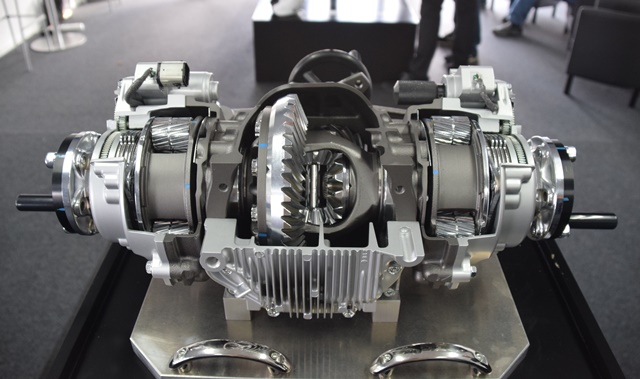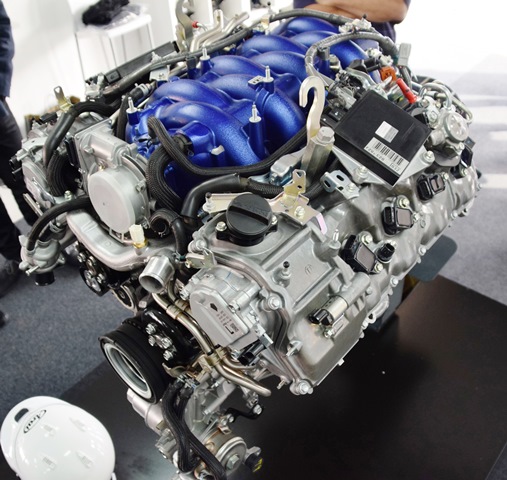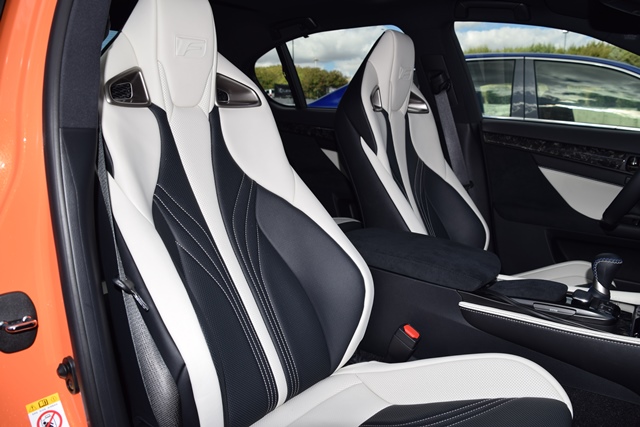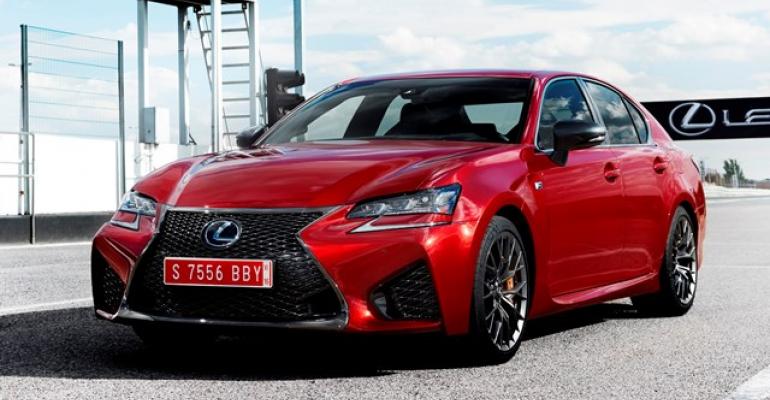MADRID – Lexus set out to redefine its brand image last year with the launch of the RC, a 2+2 coupe with sexy curves, track-ready chassis dynamics and V-6 or V-8 engine offerings. Alongside standard-bearers such as the plain-spoken ES, LS, GX and segment-leading RX CUV, the RC and its high-performance RC F variant seemed a bit out of place.
Come to find out, the RC wasn’t a mere dalliance for Toyota’s luxury brand. The limited-purpose rear-wheel-drive car has found its audience and has vaulted to the No.2 sales position behind the BMW 4-Series in WardsAuto’s Luxury Specialty segment.
With 10,458 deliveries through September, the RC is outselling the LS flagship 2-to-1 while topping rivals such as the Audi A5 and BMW 2-Series and 6-Series.
Beginning in December, the RC will have 4-door company in the ’16 GS F, a big brother bearing the same 467-hp 5.0L V-8 and an extra 4.7 ins. (119 mm) between the axles. The GS F is capable of a 4.5-second sprint to 60 mph (97 km/h), a hair slower than the smaller RC F.
This one-two performance punch is exactly what the sleepy Lexus brand needs to keep up with German luxury rivals that have successfully marketed high-performance variants of their volume vehicles.
Which explains why Lexus trots out the GS F at the Circuito del Jarama here in central Spain, a tricky, undulating course that hosted nine Formula One Spanish Grand Prix races until 1981.
On the long straightaway, the GS F stretches its legs and happily dials up 140 mph (225 km/h) as the sport exhaust conveys a level of exhilaration rarely experienced by Lexus customers, augmented by active sound control, which synthesizes exhaust and intake notes through two speakers in the cabin in Sport modes.
The baritone grows more captivating as the 7,300-rpm red line approaches on the outside too, thanks to an exhaust baffle with two types of wool – glass and stainless steel.
As the first of six tight corners closes in, the optional Brembo brakes apply more than ample stopping force with 6-piston calipers in the front and 4-piston grabbers in the rear.

It’s here, negotiating hairpins, where the GS F truly shines as the rear torque-vectoring differential responds with lightning speed by spinning the outside wheels faster, helping rotate the sport sedan through the apex and on its way. TVD adds 66 lbs. (30 kg).
The traction-enhancing technology is standard on the GS F but optional on the RC F, which comes standard with a Torsen limited-slip differential. The system operates so smoothly, the driver scarcely perceives when it keeps him off the guardrail. TVD also can be fine-tuned between settings for standard, slalom and track driving.
Fourth in F-Brand Lineup
The GS F is the fourth vehicle springing from Lexus’ “F” brand strategy, following the IS F in 2007, LFA in 2011 and RC F in 2015.
As a point of clarification, there are two levels of “F” in the Lexus portfolio, and confusion reigns. A vehicle labeled as “F-Sport” will have more aggressive looks and ground effects – all of it cosmetic.
But the GS F and these three other cars incorporate significant performance upgrades in the powertrain and chassis departments as every F-brand entry will differ from its base vehicle from the A-pillar forward.
Under the hood, the 5.0L V-8 (codename 2UR-GSE), like in the RC F, uses variable valve timing to switch continuously between combustion cycles depending on driving styles. A leisurely cruise will find more time spent in high-efficiency Atkinson mode, while hard acceleration will be in Otto mode.

Also, Lexus uses conventional static balancing to stabilize the engine in the RC F, but the GS F introduces dynamic balancing for the first time for every engine as it is installed on the assembly line in Japan.
Toyota remains one of the few automakers employing both conventional port fuel injection as well as direct injection in certain engines, including this 5.0L V-8.
Known as D-4S, this belt-and-suspenders approach to fuel delivery isn’t just technically interesting; it also boosts efficiency, reduces emissions and enables the high compression ratio (12.3:1). Premium fuel is recommended.
Sending power to the wheels is the same 8-speed automatic transmission in the RC F. In Sport S mode, the transmission is intelligent enough to select the right gear ratio by monitoring the vehicle’s g-sensor while also tracking throttle input. The wider the throttle opening, the quicker the upshift.
Dubbed Lexus G-force Artificial Intelligence Shift control, the system also will discreetly blip the throttle on downshifts.
For those seeking less excitement, softer throttle response, better fuel efficiency and fewer speeding tickets, there’s Eco mode.
GS on Customer Conquest
On the inside, the standard GS offered a handsome interior when it was all-new in 2012 (and won a Ward’s 10 Best Interiors award), and most of those cues carry over.
Red, black and gray are the interior shades offered in U.S. versions of the GS F, but other regions also will get black-and-white seats in a daring new zebra edition. Alcantara faux suede covers the brow above the instrument cluster, lending an upscale touch and reducing glare and reflection.

New exterior colors include the handsome Heat Blue as well as Lava Orange, which works great for the 2+2 coupe but seems garish for a sedan.
The standard GS is Lexus’ most successful conquest vehicle. With the GS F, the brand is delivering more than the typical midcycle refresh. A 2.0L turbocharged 4-cyl. also is new in the GS 200t this fall.
Such expansion is bound to move the Lexus needle in WardsAuto’s fiercely competitive Middle Luxury car segment, dominated by the BMW 5-Series and Mercedes E-Class. Duking it out for third place are the GS, Audi A6 and Cadillac XTS and CTS.
Lexus says it plans to sell 2,000 units of GS F, but the brand probably could sell more if it were less expensive. With a base price of $84,440 plus $940 destination charges, the GS F is a whopping $21,000 more expensive than the RC F.
That said, Lexus needs “F” the same way Mercedes needs AMG, BMW needs M, Audi needs its S and RS models and Cadillac needs its emerging “V” offerings.
It’s safe to say Lexus hopes to drop other F-bombs on its competition.
'16 Lexus GS F Specifications
| Vehicle type | 4-door, 5-passenger, front-engine, RWD sport sedan |
| Engine | 5.0L 90-degree DOHC all-aluminum V-8 |
| Power (SAE net) | 467 hp @ 7,100 rpm |
| Torque | 389 lb.-ft. (527 Nm) @ 4,800-5,600 rpm |
| Bore x stroke (mm) | 93.9 x 89.4 |
| Compression ratio | 12.3:1 |
| Transmission | 8-speed automatic |
| Wheelbase | 112.2 ins. (2,850 mm) |
| Overall length | 193.5 ins. (4,915 mm) |
| Overall width | 72.6 ins. (1,844 mm) |
| Overall height | 56.7 ins. (1,449 mm) |
| Curb weight | 4,034 lbs. (1,830 kg) |
| Base price | $84,440 |
| Fuel economy | NA |
| Competition | Audi RS6, BMW M5, Cadillac CTS V-Sport, Mercedes E63 |
| Pros | Cons |
|---|---|
| 4 doors way more practical | $21k more than RC F |
| TVD a worthy traction enhancement | Why bother with Eco mode? |
| Lava Orange sweet on RC F | Who wants Lava Orange sedan? |





